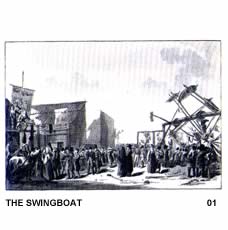MARK GERTLER and the Making of Merry-Go-Round
76' x 56'; Tate Gallery London, finished
by September 1916 and exhibited at the London Group 1917. The subject is close to my heart as it was prepared as an article for Apollo then under the editorship of Denys Sutton, It received the imprimatur of the artist's son, Luke Gertler. After Sutton's death, I heard nothing more. But I still felt that the conscious and unconscious themes not only expressed the balance in the artist between intuition and logic but also added something to this masterpiece of British painting.
My lecture was to give a context to the painting, relating it to Gertler's predicament as a Jew under fire in the East End, his interreaction with D.H.Lawrence and Gilbert Cannan. In the process I have researched contemporary imagery of the London Underground and the Circle Line, used by poor citizens to shelter. I trace the impact of Diaghilev's ballets on Mark's generation and have developed a separate database of Zeppelin imagery and ther threat from above.
 ................... ...................
 FOUR STUDIES FOR MERRY GO ROUND/ XRAY showing early compositional proposition from Sarah MacDougal'sl article in TATE etc FOUR STUDIES FOR MERRY GO ROUND/ XRAY showing early compositional proposition from Sarah MacDougal'sl article in TATE etc
 Self Portrait 1908 and a Chronology Self Portrait 1908 and a Chronology
 "Merry Go Round" photographed in the Tate August 1 2014 "Merry Go Round" photographed in the Tate August 1 2014
 A FEW WORKS BY GERTLER IN THE PUBLIC DOMAIN A FEW WORKS BY GERTLER IN THE PUBLIC DOMAIN
" Gertler is by birth an absolute little East End Jew.... He is rather
beautiful and has a funny little shiny black fringe; his mind is deep
and simple, and I think he has the feu sacre." Edward Marsh 1913. The talk addresses the problematic subject matter of the painting. Why is the image of the Merry Go Round associated with hysteria rather
than happiness ? What is the significance of the painting in its contemporary context ? What influenced its extraordinary imagery ?
The Cylic in pictorial imagery,
Hitchcock's Strangers on a Train (1951).
Gertler's early subject matter in the East End.
Early work, Rabbi and Daughter 1912.
The influence of Diaghilev and Petrouchka, 1912. The
Benois sets for Petrouchka, see A.G.Houbigant, Moeurs et Costumes
des Russes , Paris 1817, (01) lithographs
of Russian scenes upon which Benois seems to have based his celebrated
Fairground sets for Diaghilev.
The influence of D.H.Lawrence, Women in Love ,1921,written
from 1912 and The Rainbow, Sept. 1915
The Home Front during the First World War, the early
bombing raids on London, the early shelters in the Underground. Effect on civilian morale. (01. 02, 03)
 DAILY MAIL'S map of German bombing of the UK. DAILY MAIL'S map of German bombing of the UK.
The nature of Gertler's creativity." You ask what is the matter with me ? Well, it is something serious
- the greatest crisis in my life - and you know what I have already suffered
in the past. I fact for the time being I see no solution - the trouble
is- my work - what is my value as an artist / What have I in me after
all ? Is there anything there worth while after all ? That is the point
- I doubt myself - I doubt myself terribly - after all these years of
labour and you know how I worked - so so hard with my blood and I have
lived and fed up my work - my work was by faith....." letter to
William Rothenstein, c1925. September 1939, dies by his own hand.
TEXTS
1. Responses to the painting .
1.1"With its harsh flickering restlessness the painting seemed to
be a comment on Mark's life in the various scenes through which he had
passed - Whitechapel slum, young artist's Bohemia, fashionable society,
the Garsington intelligentsia. It was impossible too to look at these
mechanical soldiers going round and round without recalling the horrors
of the deadlocked Western Front....." William Rothenstein, Men and
Memories 1942.
1.2 "In this extraordinary picture the folk art figures express,
although in a more sophisticated fashion, the brutality that the boisterous
jollity of the traditional Punch scarcely masks.... Never again as far
as I am aware did his folk art figures assume so grand or so sinister
a form." John Rothenstein. 
1.3 "Your terrible and beautiful picture[in reproduction] has just
come. This is the first picture you have ever painted : it is the best
modern picture I have ever seen : I think it is great and true. But it
is horrible and terrifying. I'm not sure I wouldn't be too frightened
to come and look at the original." D.H.Lawrence.
2.Gertler on Art and Creativity .
2.1 "I paint pictures which seem to me wonderful but no one understands
them." Mark Gertler, May 1916. "Ideas for future pictures come
to me very often and these ideas are so mysterious and wonderful that
when they come over me - they come in waves - I get so excited and feel
so physically weak that I can hardly stand." MG to Edward Marsh,
August 17th, 1915.
2.2 "I get amazing visions for pictures, some of them too complicated
to paint but wonderful as ghosts. I got wonderful ideas here on Bank Holidays.
Multitudes of people. Bright feathers, swinging in and out of the clouds
in coloured boats... a blaze of whirling colour; the effect would be something
like a rainbow. It would be wonderful if one could give the effect of
the whirl and the excitement, but it's too complicated an idea to paint
yet." Gertler, letter to Carrington, 1915 written in Hampstead Heath.
2.3 "He was baffled by this association of art with things like
politics and music-halls, which he had always accepted as part of the
world's constitution, but essentially unimportant. He had no organised
mental life. His ideas came direct from his instincts to his mind, and
were used for immediate purposes or dropped back again to return when
wanted." G.Cannan, Mendel.
3. Appropriate texts; the image of the moth and the candle .
3.1 "This world in which she lived was like a circle lighted by a
lamp. This lighted area, lit up by man's completest consciousness, she
thought was all the world : that here all was disclosed for ever. Yet all the
time within the darkness she had been aware of points of light, like the eyes
of wild beasts, gleaming, penetrating, vanishing. And her soul had acknowledged
in a great heave of terror only the outer darkness. The inner circle of light
in which she lived and moved, wherein the trains rushed and the factories ground
out their machine produce and the plants and the animals worked by the light
of science and knowledge, suddenly it seemed like an area under an arc lamp,
wherein the moths and children played in their security of blinding light,
not even knowing there was any darkness because they stayed in the light.....
Nevertheless the darkness wheeled about, with grey shadow-shapes of wild beasts,
and also with dark shadow shapes of the angels whom the light fenced out, as
it fenced out the more familiar beasts of darkness."
D.H.Lawrence, The Rainbow,1915, of Ursula Brangwyn.
Lawrence as an admirer of Thomas Hardy would not have missed the use
of the image used to describe Tess in Tess of the Durbevilles.
3.2"You seem to me to be flying like a moth into a fire. I beg you
don't let the current of work carry you on so strongly that it will destroy
you oversoon.." DHL to MG
3.3 "He lived in a circle of light into which like moths came timid,
blinking, lovable figures, and he loved them ; but they passed on and
were lost in the tumultuous heaving darkness of life, into which alone
he could not enter." Gilbert Cannan, Mendel ,1916.

4. Appropriate texts; the experience of being in the Underground.
• "Last night when we were coming home the guns broke out, and
there was a noise of bombs. Then we saw the Zeppelin above us, just ahead,
amid a gleaming of clouds; high up, like a bright golden finger, quite small
among a fragile incandescence of clouds. And underneath it were splashes
of fire as the shells fired from earth burst. Then there were flashes near
the ground - and the shaking noise. It was like Milton - then there was a
war in heaven. But it was not angels. It was that small golden Zeppelin,
like a long oval world up high. Then the small, long ovate luminary, the
new world in the heavens disappeared again."
DHL letter to Lady Ottoline Morrell, Sept.9 1915. Byron Villas, Hampstead.
• "The shelters belonged, it was affirmed, mainly to the
poorer type of alien in East London; it seemed to be implied that no
true born native would be so un-British as to take cover from falling
bombs - not at all events in a Tube station. Raids being shorter in
those days, the shelterers did not have to sit it out for the whole
night. They whiled away the time riding back and forth in the train.....
returning of course to their starting point and no fares paid. The
Inner Circle as it was then called, was a particular favourite." J.A.B.Hamilton, Britain's
Railways in World War I, 1967.
•"He had never been in the Tube and, one day, with a shilling
borrowed from Harry, it seemed appropriate to him to plunge into the
bowels of the earth.The oppression of the air, the flash of the stations
as he moved through them, suited his mood, fantastic and futile." G.Cannan, Mendel.
• "
It seems to me the stark truth one has inside one is all that matters
whether it is paint, or books or life. ... I saw the Daily Mirror
today today - the Zeppelin wrecks etc. How exhausted one is by
all this fury of strident lies and foul death......." Lawrence
to Gertler Sept 1916.
• from
"The Question of Things Happening", Letters of Virginia
Woolf , 1912-1922.
781: "To
VANESSA BELL
Friday [25 August 1916]
...I
can't help being selfishly rather glad that you may spend part of
the winter in London, especially with these raids going on. We actually
had a zeppelin over the house here--in broad daylight. We were away,
but the servants say the sound is unmistakable, and were in a panic;
Nelly hiding in the wood, and Lottie running to the Woolers, where
Mrs Wooler did nothing but dash into her house and out again. But
it was so high up that no one saw it. Eleven aeroplanes chased it. I
can't help thinking it was really English."
p.112
• from
"The Question of Things Happening", Letters of Virginia
Woolf , 1912-1922.
817: "To
VANESSA BELL
Monday [22 January 1917]
"...The
fog is permanent here; by night we have the Aurora Borealis, which
a man in the street took to be zeppelins, so shouted out loud under
the servants window. At midnight we heard them carrying their bedding
to the kitchen, there to lie on the floor till day--With great difficulty
we got them up again, and lectured them on the nature of northern
lights. I think I must write the stories of our youth for Julian.
Aunt Ena is dead." p.138
 to the THE AESTHETICS OF BEING BOMBED section, 1900-1945 to the THE AESTHETICS OF BEING BOMBED section, 1900-1945
|























